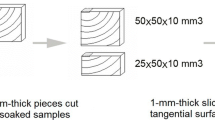Abstract
This paper describes an investigation into the influence of temperature on photodegradation rates in wood. Ten different softwood species were subjected to artificial weathering in the Xenotest 1200 at temperatures of 25, 35, 45 and 55 °C for periods of up to 400 hours. The rates of photodegradation were determined for each species at the different temperatures by monitoring the loss in microtensile strength. Photodegradation rates for the different species were shown to be temperature dependent and to increase with rising temperature. The tests appeared capable of discriminating between the photoresistance of the various species. Arrhenius plots for the species were linear with activation energies in the range 5.9–24.8 kJ/mol. It is concluded that the test methodology has the potential to differentiate the susceptibility of different wood species to photodegradation.
Zusammenfassung
Diese Arbeit beschreibt den Einfluß der Temperatur auf den Photoabbau von Holz. Zehn Nadelholzarten wurden bis zu 400 Stunden lang künstlich bewittert mit dem Xenotest bei 25, 35, 45 und 55 °C. Die Abbauraten bei verschiedenen Temperaturen wurden anhand des Festigkeitsverlustes mit Hilfe einer Mikro-Zugprüfung bestimmt. Die Abbauraten erwiesen sich als temperaturabhängig und stiegen mit der Temperatur an. Die Prüfmethode erlaubt eine Differenzierung des Photowiderstandes der verschiedenen Species. Die Arrhenius-Graphen waren linear und lieferten Aktivierungsenergieen zwischen 5,9 und 24,8 kJ/mol.
Similar content being viewed by others
References
Agrawal RK, McCluskey RJ (1983) The low pressure pyrolysis of newsprint. J Appl Pol Sci 27: 367–382
Barltrop JA, Coyle JD (1975) Excited states in organic chemistry. John Wiley & Sons
Biblis EJ (1970) Tensile properties of lobolly pine growth zones. Wood and Fiber 2: 18–28
Browning BL, Wink WA (1968) Studies on the permanence and durability of paper. Tappi 51(4): 156–163
Derbyshire H, Miller ER (1981) The Photodegradation of wood during solar irradiation. Part 1. Effects on the structural integrity of thin wood strips. Holz Roh-Werkstoff 39: 341–350
Derbyshire H, Miller ER, Turkulin H (1995) Investigations into the photodegradation of wood using microtensile testing. Part 1: The application of microtensile testing to measurement of photodegradation rates. Holz Roh-Werkstoff 53: 339–345
Derbyshire H, Miller ER, Turkulin H (1996) Investigations into the photodegradation of wood using microtensile testing. Part 2: An investigation of the changes in tensile strength of different softwood species during natural weathering. Holz Roh-Werkstoff 54: 1–6
Le Nest J.-F (1971) Contribution à l’étude du vieillissement à la chaleur et à la lumière des matériaux cellulosiques. La Papeterie 7: 644–662
Author information
Authors and Affiliations
Additional information
The authors wish express their gratitude to the UK Department of the Environment and to the British Council and the Croatioan Ministry of Science for supporting this work
Rights and permissions
About this article
Cite this article
Derbyshire, H., Miller, E.R. & Turkulin, H. Investigations into the photodegradation of wood using microtensile testing. Holz als Roh- und Werkstoff 55, 287–291 (1997). https://doi.org/10.1007/s001070050229
Issue Date:
DOI: https://doi.org/10.1007/s001070050229




